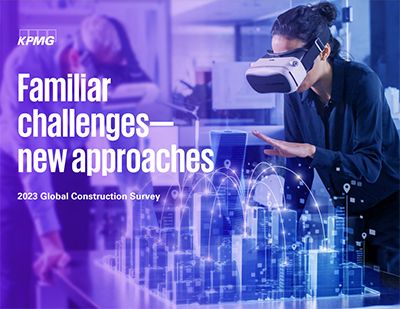Australian engineering and construction industry highlights
The engineering and construction (E&C) sector has experienced global turbulence and challenges over the past decade, and now it’s primed for change. In fact, KPMG's 2023 Global Construction Survey: Familiar Challenges - New Approaches finds the E&C industry is quietly optimistic about the future and is gearing up to address its major challenges.
Read on to get more insight into the Australian E&C industry. For an international view, download the global survey report.
Geno Armstrong, KPMG's Global Lead and Principal, Infrastructure, Capital Projects and Climate Advisory discusses the 2023 Global Construction Survey. Watch the video.
Australian infrastructure investment
Over the last decade in Australia, we’ve seen pressure on margins achieved and a rise in construction companies in liquidation, receivership or administration, but ample opportunities lie ahead. Our state and federal governments have a significant pipeline of projects to deliver, including ~$50 billion of annual defence and transport project spend, plus a further ~$800 billion of investment expected on renewable projects by 2050. Yet with the industry under significant financial pressure, it must ensure it has the capacity and technology to develop and deliver this pipeline of projects successfully.
Australia’s Infrastructure Investment Program
The Australian Government is undertaking an independent review of its 10-year $120 billion infrastructure pipeline under the Infrastructure Investment Program. For context, 10 years ago there were about 146 projects under this pipeline, and today there are 738.
Local challenges hindering progress
Rapidly increasing labour and supply chain costs, high inflation, and longer waiting times for equipment and material mean many Australian E&C organisations are facing significant challenges to deliver their projects successfully. What’s more, the reallocation of skills and material to support energy transition projects and new energy network infrastructure are significantly affecting the sector.
These challenges will drive careful consideration of effective governance, efficiency improvement, asset optimisation and capital funding prioritisation, risk-based assurance and effective Project Management Office (PMO) in the E&C sector.
Project delivery risk management strategy
The Australian engineering and construction industry is poised for a breakthrough as owners and contractors recalibrate how they partner together and deliver work. Owners will require open communication around project costs, timings and risks, while contractors will seek relationships with those who understand industry pressures and will help mitigate outsized risks. Project delivery teams who understand and jointly confront risks and plan for new challenges will survive and thrive into the next decade.
At the same time, E&C companies will be looking to provide shareholders and customers with financial stability, consistent performance, and higher margins. There is expected to be a shift away from fixed-price engineering, procurement and construction and design-construct contracts. Instead we’ll see a greater shift towards incentivised collaborative, cost-based and time-and-materials contracts with limited downside risk.
As asset owners experience a market with risk-averse contractors, they’ll need to prepare themselves for this new market by:
- establishing strong project governance and assurance
- embedding qualitative and quantitative risk management practices
- using digital information systems and data analytics for performance reporting and forecasting and scenario analysis
- developing and training project teams
- engaging early with contractors
- adopting appropriate delivery models, including incentivising performance and adjusting to changing circumstances.
Elevating project performance
Material cost escalation, labour issues and supply chain disruptions contribute to poor performance
Around the globe, the pressures facing contractors continue to cause pain: from wage and material cost escalation, supply chain disruption, and skilled labour shortages; to high profile bankruptcies and productivity rates that have not shifted much over the last 30 years. Adding to these pressures in Australia, are the diversion of skills and materials mentioned above.
Project performance remains in the spotlight in the survey, with only half of respondents completing their projects on time. This poor performance, coupled with broader construction industry challenges is putting significant pressure on contractors. There is a huge opportunity for the sector to improve its productivity and performance. This has been also recently noted in the May 2023 report from the Grattan Institute, Back in black? A menu of measures to repair the budget, “Getting major projects right is worth tens of billions.” [1]
Where to focus
KPMG strongly recommends all organisations involved in developing and delivering major projects, focus their priorities on:
- appropriate delivery/procurement models
- proper cost estimation
- achievable construction schedule
- embedded and integrated risk management practices
- robust risk quantification for both schedule and cost
- appropriate risk allocation between parties
- effective PMO
- appropriate governance and assurance practices
- integrated project controls
- enabling data analytics and technology applications.
Innovation and digital technology to revitalise the industry
Robotics, AI and data analytics are proven successful in improving productivity
Productivity remains an issue in Australia, where the construction sector lags compared to other industries. It’s worth keeping in mind, the opportunity cost of 30 years of relatively weak productivity is estimated at $47 billion.[2]
The lack of adoption of technology by the industry over many years has impacted its ability to navigate the current environment. Encouragingly though, our survey shows a rise in the adoption of technology, including mobile platforms, robotic process automation and artificial intelligence (AI), which will help improve the industry’s performance. We are also seeing prioritised investment and collaborations with tech giants to bring new and exciting innovations.
Manufacturing technology
This is the first year the survey has tracked the use of modular/offsite manufacturing, with:
- 25 percent of Australian respondents reporting they use this approach across all projects
- 61 percent starting to adopt this technology on a few projects
- 84 percent saying prefabrication is an important solution for capital projects, and collaboration across the industry as a whole is needed to advance this.
On a global level, projects using 50 percent modular or offsite manufacturing is set to rise in the next five years from 13 to 27 percent.
And when it comes to improving return on investment on developing and delivering engineering and construction projects, the project management information systems (PMIS), integrated project controls, building information models (BIMs) and advanced data analytics are considered to have the greatest potential.
ESG in infrastructure and construction
Environmental, social and governance (ESG) is rightfully top of mind for everyone across the globe. Investors and asset owners are demanding the industry looks for ways to make assets ‘greener’. Our survey shows some exciting movement in ESG agendas with industry leaders setting aggressive targets, focused on reducing their carbon footprint, waste and pollution, with an increasing awareness of biodiversity. We’re also seeing exciting collaboration to support ambitious targets, as well as an ongoing commitment to improve diversity in the workforce and increase community engagement across projects.
Diversity, equity and inclusion ranked the third most important factor determining future success. An increasing proportion of companies (50 percent) believe workplace demographics will help make construction projects more resilient by:
- addressing disruption
- bringing new skills and mindsets to tackle longstanding project cost
- addressing schedule challenges, remote working and job site travel.
Navigating the short term for long-term gains
There are clearly near-term pressures on the industry, and companies need to continue to develop new and innovative ways to improve productivity and project performance. In Australia, the engineering and construction industry outlook is positive. Those that can successfully navigate through the short-term challenges should be able to capitalise on the huge pipeline of opportunities that lie ahead.
Turning challenges into opportunities – KPMG can help
When construction and engineering leaders turn to KPMG member firms for advice, they do so because KPMG professionals understand the industry at a local, national and global level. For decades, we have provided services tailored specifically to meet the needs of the industry. To do this, we have created a diverse practice that includes strategists, financiers, certified public accountants, professional engineers, architects, project managers, owner representatives, contract and procurement specialists, tax professionals, business valuation specialists, cost estimators, certified fraud examiners and technology specialists.






